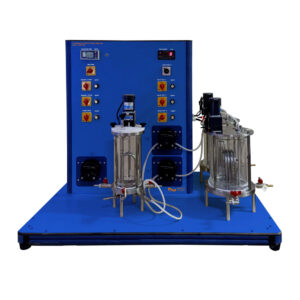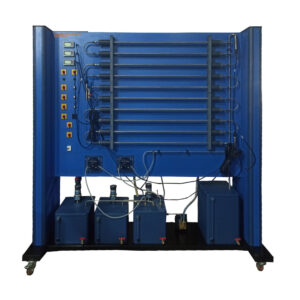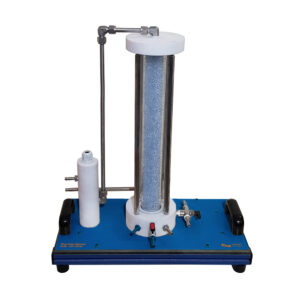This unit explains the fundamentals of hot air tray drying. The device is made out of a rectangular duct. An axial flow fan at the left end of the duct draws air into the space. Fan speed can be changed. After the fan, a bank of electric heaters enhances the air’s temperature. Above the duct, a balance holds a rack of trays in the air. Before and after the drying trays, temperatures and humidity are recorded.In food technology, convection dryers are frequently used to dry solids. Convection drying of granular particles can be studied and shown using the tray dryer. The solid can be dried using four removable pans that resist rusting. They are put in a canal for drying. The drying material is placed in trays that are exposed to an air flow in a channel. The solid is heated by the air flow, which also draws out any released moisture. The speed of a fan can be changed to change the air velocity. The air can be heated with a variable heater. The drying process may be seen thanks to the trans parent door in the drying channel.
A digital balance can be used to monitor variations in the solid’s weight brought on by the evaporation or vaporisation of moisture while it is in use. Before and after the air flow passes over the solid, a single combined temperature and humidity sensor measures the air temperature and relative humidity and digitally displays the results. The air velocity is measured by another sensor.Direct transfer to a PC of the pertinent measured parameters (changes in weight, humidity, temperature, and air velocity) allows for additional processing (optional). The comprehensive course materials outline the foundations and offer a step -by-step walkthrough of the experiments.
Experiments
- Influence of air temperature and humidity on drying intensity.
- Plotting of drying curves with constant external conditions.
- Determination of drying rate with different air parameters and different solid properties.
- Evaluation of drying processes using energy and mass balances.
Specifications
- Drier for investigating convection drying of solids.
- Drying on 4 corrosion resistant trays in a drying channel with an air flow.
- Adjustment of air velocity via speed of fan.
- Air heating with controlled heater.
- Digital balance for measuring the change of weight during drying.
- 1 combined sensor for measurement of humidity and temperature before and after the solid sample.
- 1 air velocity sensor.
- Digital stopwatch, battery operated.
- Software (Optional) for data acquisition via USB under Windows Vista or Windows 7.




